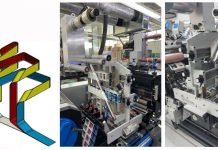In 2018, we had an opportunity to visit the brand new Uflex Asepto plant in Sanand in the state of Gujarat in Western India. At the time, we didn’t really have an idea of what to expect although we knew it was a large greenfield project for liquid food packaging and that it used a Gallus wide web flexo press. Now as we write, the plant has completed a full year of commercial production.
In our meeting with Ashwini Sharma, president and chief executive officer of New Business Initiatives at Uflex, in June, he updated us on the Asepto project, “The initial stages of the investment have been encouraging. We have good brands under our belt and the good part is that the new brands are seriously exploring doing business with us. We offer an attractive product to the market and people see a lot of value in what we do.”
Sharma says the liquid packaging market in India is over 10 billion packs, adding, “Last year’s growth was 17% and this year we see the growth rate improving. The three large consumption segments in India are non-alcoholic beverages, alcoholic beverages and dairy products. In the beverage segments, healthy drinks seem to be popular. . . Our converting plant is designed with a capacity of 7 billion packs but at present our maximum converting capacity is 3.5. billion packs.” Designed for growth, Asepto’s converting capacity can be augmented or optimized when feasible with minimal additional capex on the infrastructure.
Our visit to Sanand took place when brand owners were still conducting trials. The situation now has progressed to the extent that the Asepto laminate is being supplied to several brand owners in the juice, dairy and alcobev segments. The Asepto laminate has also already found export customers on other continents. In addition, more than half a dozen of the Asepto Smart 78 filling and sealing machines manufactured by Uflex’s Engineering Division in Noida have also been placed at customer sites.
According to Sharma, most of the Asepto customers are using the popular 200 ml packs. “When you look at the beverage market, over 90% of beverage is sold in portion packs of 200 ml, 165 ml and 100 ml, while the larger packs make up for a small percentage of the market. In the alcoholic beverage segment, the 100 ml packs are growing in a big way.”
The Asepto WOW! factor
Sharma explains that the company has divided the market and devised strategies to deal with each segment separately, “What the customers want is to know how to build a brand and how to sell the maximum units. In order to do that we created these holographic effects and commercialized the packs. Nobody in the world is using the foil stamping effects on liquid packaging pack that we are. It has a cost obviously and initially customers may resist, but we are moving ahead and have brands such as Fresca and Juicico. Today our laminate is already running with top brands on high speed machines and we have over 50 customers. At the same time, our first shipment will run outside India this month.”
The Asepto laminate sets itself apart from others because of its premiumization using a range of metallic and embossed decorative effects. Using a unique transfer technology, the laminates contain a range of metallized sparkling, shining and raised surfaces that evoke holographic and 3D effects. This premiumization is the Wow factor to make Asepto a successful, value-added laminate provider. The effects are innovative because they are done using only a 6-layer laminate.
The value-adds and metallic effects have already helped some of Asepto’s dairy and juice brand customers such as Fresca to make their products stand out on the shelf. The premium metallic and embossing combinations certainly add a bit of zing or Wow factor to the easy to carry, single serve and tamper-proof Asepto packs, which have also become popular for the sale and consumption of alcoholic beverages.
Producing the laminate
The objective of the Asepto plant is to provide laminate rolls that can be aseptically formed and filled by liquid food and beverage manufacturers on specially designed liquid filling and sealing machines such as the Asepto Smart 78 that is manufactured by the Uflex Engineering Division in Noida. In order to ensure that the packaging is totally aseptic, these machines pass the laminate through a hydrogen peroxide bath before the forming, filling and sealing operations. Sharma says, “We have already sold 6 filling and sealing machines; we are in the process of building another three and we will start building another one soon. We are receiving enquiries in the commercial segment from outside India for the laminate and the machines as well.”
Asepto’s laminate for aseptic liquid food and beverage packaging consists of six layers. The top layer is a protective PE layer and the second layer, which gives the package its shape, stand-up and stackable stiffness, is made of paperboard that is imported from the BillerudKorsnas and Stora Enso paper mills in Sweden. The third layer is of aluminum foil, which provides additional high-level oxygen, moisture and light barrier properties. The fourth is a PE tie-layer which binds the outer layers of the composite laminate to the inner 5th and 6th layers of PE.
The printed decoration of the paperboard layer of the laminate is done on a 7-color Gallus Intro 1320 mm wide unit to unit flexo press capable of running at 500 meters a minute and equipped with a Martin Automatic unwinder, autosplicer and rewinder. Regarding the technology, Sharma says, “For this particular flexo application, you need to have a high-end machine and Gallus is the best machine today that money can buy. In the liquid packaging segment, Gallus is undisputedly the best machine.”
The Gallus press contains an inline tooling unit that is used for creasing, perforation and punching the holes required for the use of straws with many of the beverage products. Water-based flexo inks designed for food laminate production are provided by DIC, which also has an ink kitchen within the plant.
As Manoj Nair, the vice president of operations at Asepto, explained to us in Sanand, “The 6-layer structure is assembled on a Davis Standard extrusion laminator in one go. This machine has been future enabled with an unwinder for films as well. Slitting and rewinding is done on an IMS Goebel slitter-rewinder, which produces the standard reels for the Asepto Smart 78 filling and sealing machines or those of other manufacturers.” The standard slit reels of laminate are stacked on pallets and wrapped by an automated robotic logistics system from ITW Signode with 16 stations helping to maintain the end-to-end hygiene of the process.
Best practices including the ISO 22000 Food Safety Guidelines and the BRC Issue 5 standards are maintained. Apart from these, there is an integrated quality management system. The plant also has ISO 9001, 14001 and 18001 certifications. The well-equipped lab maintains the globally accepted product quality standards at the Sanand plant with measuring instruments from L&W and Instron and more than a dozen others. All the process owners at the Sanand plant and key machine operators have rich experience in the liquid packaging industry and have contributed significantly in establishing the unique Asepto laminate in the market.
Additionally, Asepto has built up strong engineering and technical teams in Delhi, Mumbai and Bengaluru for servicing its Smart 78 liquid packaging filling and sealing machines. The Engineering Division in Noida, which manufactures the filling and sealing machine, also contains a demonstration machine as well as a testing laboratory for proving the total efficacy and performance of the laminate and packaging. Materials are also periodically sent to internationally approved labs for establishing globally accepted norms and certifications for the laminate and the process. z
Elegant industrial architecture

When we arrived at the Asepto plant in Sanand, about 75 minutes by from Ahmedabad airport, we were surprised by the project’s magnitude and its purpose-built but imaginative architecture. The two main structures and their service spaces use up approximately 22 acres of the 72-acre site. The architecturally stunning 100,000 square foot glass-walled executive block of the Asepto plant with landscaping and a fountain first come into view. The two buildings make up a total of 400,000 square feet of extremely modern and purpose-built industrial spaces.
A production block of 300,000 square feet contains the raw materials and finished goods stores, services, printing, laminating, slitting and rewinding machines, materials testing and quality control laboratory and automated logistics. The space is completely air-conditioned and hygienically maintained to keep the microbiological load of the production environment to global standards. Designed for growth, converting capacity can be added or optimized with minimal additional capex on the infrastructure. The Asepto liquid packaging plant is the first major piece in the 72-acre Uflex site. The 72-acre site itself can accommodate three or four such plants depending on the company’s growth strategy.
Anantshree Chaturvedi on the Uflex Asepto project in Sanand

Soon after we visited Sanand in 2018, we asked Anantshree Chaturvedi a couple of questions about his views of the new greenfield plant, the new line of business and the future use of the site itself. His response was included in our February 2018 cover story.
“The aseptic liquid packaging project is yet again another example of Uflex taking on a massive challenge and utilizing a gap that exists in the market to provide a niche solution to large set of customers who have not imagined a different way to package liquids in flexible packaging containers for the last 40 years. Asepto is the start of a new era of not only products, but of a business philosophy that will change the future of Uflex from being a flexible packaging and polymer science company to a product development and material science company.
“The state-of-the-art production facilities of Asepto are the latest and best example of a philosophy that Uflex has always followed – never buy a used machine, when you can buy a new one. Also, never buy old technology when a new one exists or is on the cards to be implemented and deployed in the future. This combined with our product creation philosophy is what enables Uflex to take on ambitious and groundbreaking challenges.
“With regards to the remainder of the three-fourths of the land at Sanand, Gujarat, there are certainly many businesses within Uflex that are interested in expanding in that space. My estimate is that the most profitable businesses – holograms, chemicals, and engineering – might get the right of first refusal to go into the rest of the land. However, nothing is really off the table including new ideas and concepts that Uflex is currently working on.”












Thank You Mr.Naresh Khanna, for putting time and effort into writing this informative article on the Asepto plant in Sanand. It was a very good read as it gave us readers a wide-ranging perspective of what the Asepto plant does and the laminate being used for packing juice, diary and alcobev companies and brands.
Great Content, I found it really helpful, thank you for sharing.
We appreciate Mr. Neresh Khanna’s time and work in researching and producing this essay on the Asepto facility in Sanand. It was an excellent book because it provided readers with a comprehensive understanding of the work done at the Asepto plant and the laminate used to package juice, dairy, and alcohol companies and brands.